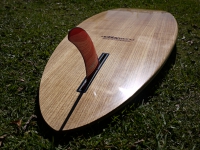An Itago Interview-1
インタビュー:舛田’クニ’邦人
2012年11月22日
with Kunihito 'Kuni' Masuda
November 22, 2012
Mail interview by Nobby
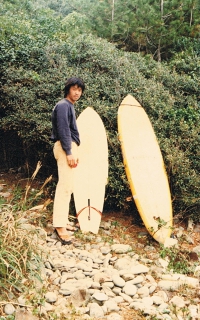
Courtesy / Kunihito Masuda
徳島 / 1970年代初期
Tokushima / Early 70's
舛田’クニ’邦人
Kunihito 'Kuni' Masuda
1952年生まれ、徳島県恵比寿浜在住
Born in 1952 and have lived in Ebisuhama, Tokushima.
1: いつ、何処で板子乗りを始めましたか?
-1963年頃に、徳島県・恵比寿浜で始めました。
1: When and where did you start Itago riding?
- We ("Kuni" Masuda and "Wayne"Hamaguchi) had began to ride Itago around 1963
at Ebisuhama beach, Tokushima prefecture.
2 : どのような板で乗っていましたか?
-真四角で持ち手の穴の無い板でした。
長さ約70cm、幅約30cm、厚さ約2cm、材質は杉でした。
2 : What type of board did you ride?
- The itago had a rectangle out line, no hand hald,
It was about 70cm length, 30cm wide, 2cm thick.
and was made from Japanese ceder.
3 : 板子を使ってどのように乗りましたか?どのような波が板子に適していましたか?
-白波を真っ直ぐに乗っていました。なぜなら、恵比寿浜はダンパー波だったからです。
私達は真っ直ぐ乗る事が板子乗りだと思っていましたし、白波でも充分に楽しかったのです。
3 : How would you ride an itago? What sort of wave were they suited to?
- We rode it straight in on the white water because of the dumper break.
but we thought that was the Itago riding and we had so much fun on the white water.
4 : 波を捕まえていた場所は水深の深い所ですか?
もしくは足の着く所で海底の砂あるいは岩を蹴って捕まえていましたか?
-普段は、浅い所で砂の海底を蹴って波を捕まえていましたが、
波の大きな時は足ひれを付けてアウトサイドから乗っていました。
4 : Could you catch a wave in deep water or were you restricted
to standing up and pushing off the sand or rocks?
- We usually caught a wave in shallow water where we can stand on the sandy bottom,
however when a big swell come, we rode from outside with swim fins.
5 : 日本の他の地域で板子乗りを見た事がありますか?
また上手に板子乗りしていた人を憶えていますか?
-私達は若く、他の地域の事は知りませんでした。
ただ隣の牟岐地域で、板子乗りがされていた事は知っていました。
5 : Did you see itago ridden in other areas of Japan?
Who do you remember as being a good itako rider?
- We only saw itago rideing at a nearby beach 'Mugi'
We heardly ever saw and didn't know good itago riders and the situation in other areas,
because we were too young.
6 : どの位の期間板子で遊んでいましたか?
-私達は1963年から1970年頃まで板子で遊んでいました。
6 : For how many years did you ride an itago.
- We rode itago from 1963 to 1970.
7 : 板子乗りの楽しかった所は何でしたか?
-板子乗りの楽しかった所は、滑空感・浮遊感・波との一体感です。
7 : what did you enjoy about itako surfing.
-I liked the feeling of a glide, floating on the wave, and
feeling of identification with the wave.
8 : どのように板子は作られていましたか? またデザインは時と共に変化しましたか?
-浜口家の父親は船大工で、同時に海の家も経営していました。
彼は地元の子供達や海水浴客に沢山の板子を作っていました。
彼の作る板子は造船の知識を取り入れて作っていました。
8 : How were they made? Did the board design change over time?
- 'Wayne' Hamaguchi's father was a shipwright and owner of a beach house.
He had made Itago for a lot of local beach boys and sea bathers.
His board design was influenced by knowlege of marine engineering.
9 : いつ頃から、エアーマットサーフィンを見かけましたか?
-1968年頃です。
9 : When did you see air mat surfing?
-Around 1968.
10 : いつ頃から、ボディーボードを見かけましたか?
-70年代に入ってからです。
10 : When did you see bobybording?
- Around 1970's.
11 : いつ頃から、フォームサーフボードを見かけましたか?
-1972年頃です。
11 : When did you start surfing with foam surfboard?
- Around 1972
12 : 板子乗りと波乗りに関する土地の言葉を教えて下さい。
- 板子=”板” 板子乗り=”板乗り” Surf=”波乗り”
Surfing=”つかす” 大波=”ざんまな” ダンパー=”いっさん”
アウトサイド=”だいなん” インサイド=”へたばり” チューブ=”穴”
チョッピー=”ガチャ波” フィン=”舵” Twin fin=”二本舵”
Tri fin=三本舵 ノーズ=”へい” テール=”とも”レール=”みよし”
Rock bottom=”おおばえ”
12 : What words did you use to describe around itago riding and surfing?
- "Itago"="Ita" "Riding itago"="Ita-nori" "Surf"="Nami-nori"
"Surfing"="Tsukasu" "Big wave"="Zanmana" "Dumper wave"="Issan"
"Outside"="Dainan" "Inside"="Hetabari" "Tube"="Ana"
"Choppy"="Gacha-nami" "Fin"="Kaji" "Twin fin"="Nihon-kaji"
"Tri fin"="Sanbon-kaji" "Nose"="Hei" "Tail"="Tomo" "Rail"="Miyoshi"
"Rock bottom"="oobae"
13 : 現在も板子は持っていますか?
-持っていません。
13 : Did you still have an Itago?
-I haven't
An Itago Interview-2
インタビュー: 浜口’ウェイン’和弘
2012年11月22日
with Kazuhiro 'Wayne' Hamaguchi
November 22, 2012
Mail interview by Nobby
 Courtesy / Kunihito Masuda
Courtesy / Kunihito Masuda
造船所前、恵比寿浜 徳島 / 2012年 6月
Infront of his ship yard, Ebisuhama / Jun, 2012
浜口’ウェイン’和弘
Kazuhiro "Wayne"Hamaguchi
1953年生まれ、徳島県恵比寿浜在住
Born in 1953 and have lived in Ebisuhama, Tokushima.
1 : 板子乗りの楽しかった所は何でしたか?
-板子乗りの楽しかった所は、スピードのスリルです。
1 : What did you enjoy about itako surfing.
- I liked the thrill of the speed.
2 : どのように板子は作られていましたか? またデザインは時と共に変化しましたか?
-私の父(浜口富夫)が作っていました。
標準的な四角い板子と、ラウンドノーズ、フレアーアウトラインそして、
ボトムのノーズ寄りのレールにベベルカットを施した板子を作っていました。
2 : How were they made? Did the board design change over time?
- My father (Tomio Hamaguchi) had made typical rectangler Itago and
evolved Itago that has round nose, flared outline and bevel rail cut at front of the bottom.
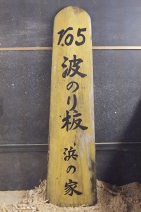
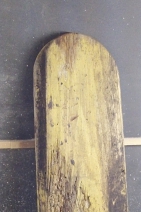
表記: No.5 波のり板 浜の家
Written on the deck: "No.5 Wave riding board, owner: Hama-no-ya beach house "
3 : 四角からデザインを変えたのはいつ頃ですか?
-1970年頃。
3 What time period the boards evolve from rectangular to rounded noses.
- Circa 1970.
4 : 何年位作っていましたか?
-3~4年位。
4 : How many years did Tomio Hamaguchi make the itago?
- for 3~4years .
5 : 恵比寿浜で他に海の家はありましたか?
-他に一軒、”エビス・ロッジ”という民宿がありました。
5 : were there some beach housse in Ebisuhama?
-There was a beach house with a guest house which was called"Ebisu・lodge".
6 : 恵比寿浜で他に作っていた人はいましたか?
-いませんでした。
6 : were there some Itago makers in Ebisuhama?
-Nobody made Itago expect Tomio Hamaguchi in Ebisuhama .
7 : 父(浜口富夫)さんは板子で遊んでいましたか?
-父も子供の頃遊んでいたはずです。
7: Did Tomio Hamaguchi ride on Itago?
-I expect he would ride with Itago when he was yang.
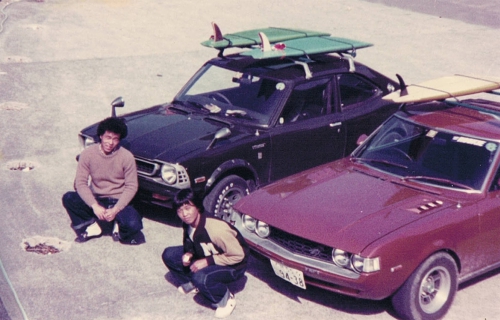 Courtesy / Kunihito Masuda
Courtesy / Kunihito Masuda
徳島 / 1970年代初期
Tokushima / Early 70's
左:浜口’ウェイン’和弘 右:舛田’クニ’邦人
Left: "Wayne"Hamaguchi, right: 'Kuni' Masuda
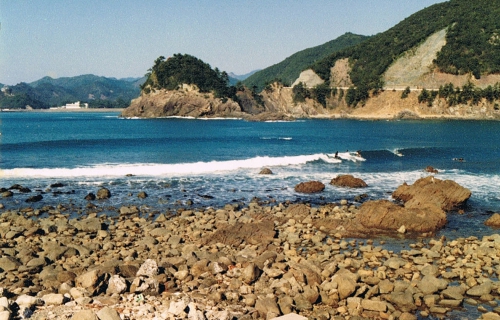 Courtesy / Kunihito Masuda
Courtesy / Kunihito Masuda
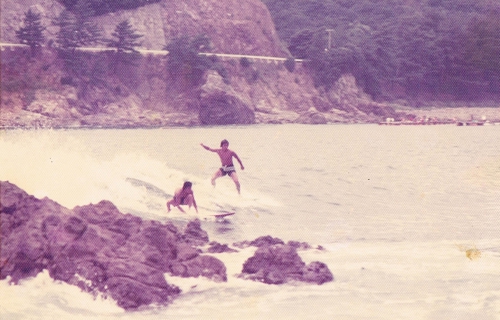 Courtesy / Kunihito Masuda
Courtesy / Kunihito Masuda
恵比寿浜 アウトサイド、 徳島 / 1970年代初期
outside of Ebisuhama, Tokushima / Early 70's
追記
彼らは1972年頃にファイバーグラスのサーフボードを買い、サーフィンをしていました。
それまではインサイドで板子を楽しんでいました。
Postscript
They bought glassed surfboards and surfed on pictured waves circa 1972,
before that, thay rode with Itago at inside section (!).
An Itago Interview-3
インタビュー: 塚越”ツカチャン”東男
2013年6月9日
with Haruo 'Tsuka-chan' Tsukakoshi
Jun 09, 2013
Interview by Nobby
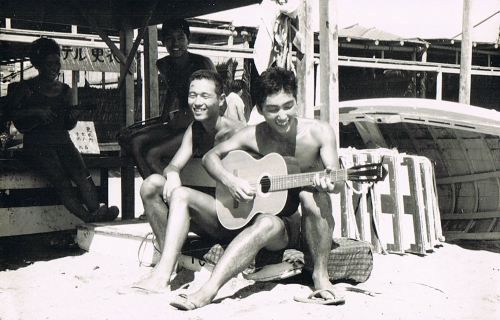 Courtecy / Haruo Tsukakoshi
Courtecy / Haruo Tsukakoshi
逗子、神奈川 / 1962年
Zushi, Kanagawa / 1962
右: 塚越”ツカチャン”東男
Right: Haruo 'Tsuka-chan' Tsukakoshi
1942年生まれ、神奈川県逗子在住
Born in 1942 and have been live in Zushi, Kanagawa.
1 : いつ、何処で板子乗りを始めましたか?
-1960年代初旬に神奈川県逗子海岸で始めました。
1 : When and where did you start Itago riding?
-I had began to ride Itago early 1960's at Zushi beach Kanagawa prefecture.
2 : どのような板で乗っていましたか?
真四角で持ち手の穴のある板でした。
材質は多分杉です。
2 : What type of board did you ride?
-The Itago had a rectangle out line with hand hall.
It probably was made from Japanese ceder.
3 : 板子を使ってどのように乗りましたか?どのような波が板子に適していましたか?
-波が崩れる直前に乗り、頂上から滑り下りていました。
ゆっくり崩れる波が板子に適していました。
3 : How would you ride an itago? What sort of wave were they suited to?
-I caught a wave at the peak before break and rode it straight in on the face.
I thought that a wave suitable for riding Itago is slow- braking wave.
4 : 波を捕まえていた場所は水深の深い所ですか?
もしくは足の着く所で海底の砂あるいは岩を蹴って捕まえていましたか?
-基本的には足の着く所です。
波の状態が良ければ少し沖から捕まえていました。
4 : Could you catch a wave in deep water or were you restricted
to standing up and pushing off the sand or rocks?
-Basicaly, I caught a wave in shallow water where I can stand on the sandy bottom.
however, when a good condition, I rode from bit outside.
5 : 日本の他の地域で板子乗りを見た事がありますか?
また上手に板子乗りしていた人を憶えていますか?
-当時、見た事はありません。
5 : Did you see itago ridden in other areas of Japan?
Who do you remember as being a good itako rider?
- I have never seen in other beach.
and I have never known good Itago rider at that time.
6 : どの位の期間板子で遊んでいましたか?
-1960年代初旬から4~5年間。
6 : For how many years did you ride an itago
-I rode Itago 4or5 years in the early 1960's
7 : 板子乗りの楽しかった所は何でしたか?
-頂上から滑り降りる時、波の力を腹に感じる時。
7 : What did you enjoy about itako surfing.
-I liked the feeling of drop from peak of the wave,
and the feeling of wave power at my stomach.
8 : どのように板子は作られていましたか? またデザインは時と共に変化しましたか?
-自分で作りました。白と赤のラインを塗り、自分の家内の名前"Yoko"を入れました。
8 : How were they made? Did the board design change over time?
-I made it, painted the both surface white and red lines and signed my wife's name "Yoko"
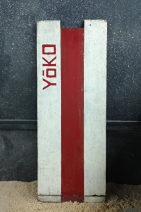
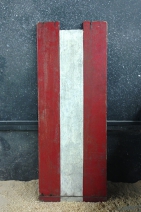
He made the board in early 60's.
Zushi beach where he surfed had a lot of beach houses in the summer season
and the houses hired out itako for sea bather.
His board was influenced by the itako of the beach houses.
The color red and white remind us 60's fiberglass surfboard
but he didn't know surfboard at that time it's his design for his girlfriend
...Now she is his wife.
An Itago Interview-4
インタビュー: 上ノ山"ミッチャン"満男
2013年7月24日
インタビュアー: ジョン・クラーク
An Itago Interview with Mitsuo Uenoyama
July 24, 2013 - Zaimokuza Beach, Kamakura
Interview and photos by John Clark
前書き
Introduction

John on Waikiki Beach with an Itago board from Michan.
2007年に私と私の家族は日本を訪れました。
私の妻’Julie Ushio’は日系3世で、子供達”Sachi”、”Koji”と
福岡県、飯森神社にいる”Julie”の親族に会いに行く
それが訪日の理由の一つでした。
東京から福岡に行く途中で私達は鎌倉に寄り、”鎌倉パークホテル”に宿泊しました。
そこで、そのホテルのフロントで働いていた”Mie Inage”さんと知り合いました。
彼女は英語が話せ、ボディーボードをしている事を知りました。
数年の間で何回か訪日していた時、Mieさんもハワイを何回か訪れ、ワイキキに滞在しました。
彼女が来る度に、私達は一緒にサーフィンをし、良き友達になりました。
In 2007, my family and I visited Japan.
My wife, Julie Ushio, is a sansei (third generation Japanese in the U.S.),
so one of the main reasons for our visit was for me and our two children, Sachi and Koji,
to meet her family at Iimori Shrine in Fukuoka.
On our way from Tokyo to Fukuoka,
we stopped in Kamakura and stayed at the Kamakura Park Hotel.
There we met Mie Inage who works at the front desk.
Mie speaks English, and we soon learned that she is a bodyboard surfer.
In the years that followed our visit to Japan, Mie came to Hawaii several times and stayed in Waikiki.
She and I went surfing each time she came, and we became good friends.
2011年に、ハワイ大学の出版部が私の書いた本
'Hawaiian Surfing: Traditions from the Past' を発刊しました。
私がその為にハワイの伝統的なサーフィンを研究している間、
同時に日本の伝統的なサーフィン”板子乗り”も学んでいました。
私はもっと知りたくなりインターネットで調べていると、
素晴らしい板子乗りの歴史が書かれた”Nobbywoodsurfboards”のウェブサイトを見つけました。
その歴史考察文はNobbywoodsurfboardsオーナーの、
”Nobuhito "Nobby" Ohkawa”によって書かれていました。
同じく”Mie”さんにも連絡を取りました。
彼女は以前板子を鎌倉の浜でレンタルしていた、
漁師の”上ノ山 "Michan" 満男さんを知っていました。
In 2011,the University of Hawaii Press published a book I wrote called
"Hawaiian Surfing: Traditions from the Past."
While I was researching traditional Hawaiian surfing,
I also learned about itago-nori, traditional surfing in Japan.
I wanted to know more, so I checked on the Internet
and found a wonderful history of itago-nori on the website for Nobbywood Surfboards.
The history was written by Nobuhito "Nobby" Ohkawa,
the owner of Nobbywood Surfboards.
I contacted him by email,
and we began exchanging information about surf history in Japan.
I also contacted Mie about itago-nori,
and she told me she knew a fisherman named Matsuo "Michan" Uenoyama
who used to rent itago boards on the beach in Kamakura.
2013年、私と家族は日本に戻ってきました。
最初に私達は千葉のNobbyの店に立ち寄り、
彼の収集した板子と波乗りフロート、そして彼が作る美しいボードを見る事が出来ました。
In 2013, my family and I returned to Japan.
Our first stop was in Chiba, where we met Nobby and visited his shop.
In addition to seeing the beautiful boards he makes,
he showed us his collection of itago boards, which includes one float board, a naminori furouto.
After Chiba, we stayed again at the Kamakura Park Hotel,
where Mie arranged for me to meet and interview Michan.
In addition to meeting Michan, we made a side trip to the Oiso Municipal Museum,
which has a nice collection of itago boards (see below figures).
Mitsuo Uenoyama is a life-long fisherman who was born and raised in Kamakura, Japan.
Like many fishermen in Kamakura, he has a shop on Zaimokuza Beach
where he stores his fishing gear and rents rowboats and small sailboats. In the old days,
he also rented itago-nori and naminori furouto.
The itago-nori are small wood bodyboards, which were ridden prone,
and naminori furouto are larger hollow wood boards, which were ridden standing up.
The rentals were a side business to supplement his income from fishing.

Nobby in his shop.
Mitsuo Uenoyama Interview
Zaimokuza Beach, Kamakura. July 24, 2013.
Mitsuo Uenoyama is a life-long fisherman who was born and raised in Kamakura, Japan. Like many fishermen in Kamakura, he has a shop on Zaimokuza Beach where he stores his fishing gear and rents rowboats and small sailboats. In the old days, he also rented itago nori and naminori furouto. Itago nori are small wood bodyboards, which were ridden prone, and naminori furouto are larger hollow wood boards, which were ridden standing up. The rentals were a side business to supplement his income from fishing.
Everyone knows Mitsuo as Michan. His family home is in Zaimokuza, the community just inland from the beach. His grandfather, Senzou Uenoyama, was a fisherman who started the family’s beach rental business on Zaimokuza Beach in the early 1950s. The original shop was closer to the harbor, which is to the east of the beach. Michan’s shop now is on the west side of the Zaimokuza lifeguard headquarters, where he asked me to meet him. The lifeguards know him well and call him the original “beachboy” of Zaimokuza Beach. They offered the use of their office for the interview.
Michan was born in Kamakura on July 16, 1946. He was six years old when he first started using the itago nori and the naminori furouto rental boards in his grandfather’s shop, so he started surfing in the shorebreak at Zaimokuza Beach in the early 1950s.
When he was 16, he tried a surfboard from Hawaii. A professional baseball player from Hawaii named Oodate brought a foam surfboard to Kamakura. It was the board that Elvis Presley used in the movie Blue Hawaii (1961). Oodate’s son lived in Kamakura, so Michan and his friends all tried the board. In later years, when Oodate’s son was renovating his house, he threw away the historic Elvis Presley surfboard.
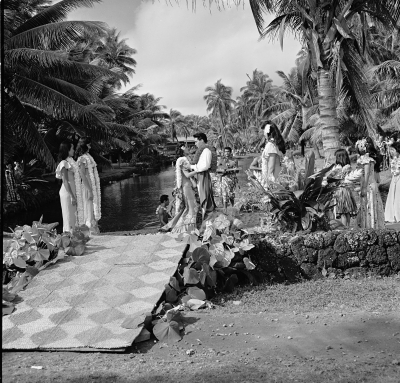
Blue Hawaii (1961) / Courtesy of Clarence Maki
Although the men in his family have been fishermen for many generations, Michan’s father worked for Mitsubishi. He didn’t help out at his father’s shop on Zaimokuza Beach, but Michan began helping his grandfather there when he was in middle school. When he graduated from high school, he worked full-time at the shop and eventually took it over. He had 15 itago nori boards and 20 naminori furouto boards in his shop. He charged 30 yen to rent the itago boards and 150 yen to rent the float boards. In addition to his shop, there were four other shops on Zaimokuza Beach that rented boards.
In the old days, there were many more people who came to the beach and rented their equipment. People with breathing problems used to come to Kamakura. His mother would come down to the shop three times a day and take the money from the rentals to the bank. His stand was a popular gathering place and attracted many girls.
Both the itago boards and the float boards were in use when he was a child. He doesn’t know their history. The coast road along the beach was built during the 1964 Tokyo Summer Olympics. Before that the communities behind the beach were more isolated.
In later years as wood became more expensive and plastics were developed, interest in the old wood boards died out. His boards were handmade by the man who made their boats. The itago boards had a top piece and a bottom piece (like a tail block), but Michan didn’t know why they were made that way. These pieces were just nailed on the top and bottom of the boards. If they came off, the nails would stick out, which was dangerous. The nails were the same as the ones used to build temples.
He never saw the inside of a float board, so he doesn’t know what the interior frame looks like. Each of the boards had a mizu wonuku, or a drain plug. To catch a wave, a surfer would stand on the float board and paddle with a wood paddle. Michan stood up and demonstrated the movement, which was paddling with alternating strokes on either side of the board. This was possible because the paddles had a blade at each end of the handle, so the surfer held the middle of the handle and paddled alternately on either side. Michan explained that if you were going to grab the rope in front of the board, you put the paddle down in the middle of the board between your legs, grabbed the rope, and held it while you rode in. If you were a good surfer, however, you didn’t need to hold the rope.

Five itago boards in the Oiso Municipal Museum.

Nobby demonstrates how to paddle a float board. Four itago boards are against the wall.
Today he only rents rowboats and small sailboats. The name of his shop is the same as his last name, Uenoyama, which is the same for all the shops on the beach. The shop owners pay rent to the province to be on the beach, and the amount they pay is determined by the size of the shop.

Michan, Nobby, Mie, and friend with the float board.

 contact > Nobby
contact > Nobby

